Hybrid horsepower We drive a 330e plug-in hybrid over 650 miles to see if we can get anywhere near BMW’s claimed economy figures.
With sales of electric cars on the up in the UK – and the rest of Europe – there’s evidently a growing demand among motorists for more environmentally-friendly vehicles. As far as BMW is concerned, its electrified models continue to exceed expectations and, while currently running at just 4% of overall sales in Western Europe, the figures are much more impressive in markets where innovative electric mobility is particularly well supported. So, for example, 43% of BMW 3 Series registrations are for the plug-in hybrid 330e model in the Netherlands. In Scandinavia, the figures are higher still.
SAMPLING THE FUTURE
Few seem to argue nowadays that electrification – in some form – represents the future as far as passenger cars are concerned. Most of the major vehicle manufacturers are pouring development money into this area now and BMW is no exception. The iPerformance range continues to expand at an impressive rate, with the 330e being something of a standard bearer, in terms of its potential appeal; five-seater, family saloon with strong brand image and lashings of driver appeal. What’s not to like?
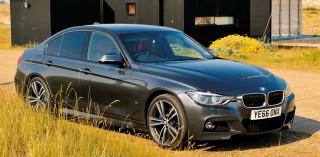
Well, in a bid to find out, I decided to run a test car over an extended period, to really get a feel for life with a modern, plug-in hybrid. The BMW 330e saloon was introduced in 2016, and pairs an 184bhp, 2.0-litre petrol engine with a 65kW (88bhp equivalent) electric motor. The combined power output of the two is quoted as 252bhp, with the additional benefit of 420Nm of torque. This is enough to push the car to 62mph in 6.1 seconds, and on to a top speed of 140mph.
The 7.6kWh, high-voltage lithium-ion battery pack is tucked away under the boot floor, and is kept in peak condition by its own refrigerant cooling system. BMW claims that it’s powerful enough to run the car in all-electric, emission-free mode for around 25 miles. This battery/engine pairing gives the 330e official figures of 148.7mpg and 44g/ km of CO2 emissions.
DRIVING MODES
There’s a choice of three driving modes; AUTOeDRIVE, MAX eDRIVE and SAVE BATTERY. With the first of these selected – which happens as default when the car is switched on – the maximum electric speed is limited to 50mph, and the engine and electric motor work together to best effect. The MAX eDRIVE setting switches the car into electric-only mode, for zero-emissions driving with a top speed potential of 75mph. The SAVE BATTERY mode sets the car to use its conventional engine, only, and actively replenishes the battery pack if its reserve of charge has dipped below 50%.

There’s also the capability for the BMW ConnectedDrive system to work in tandem with the sat nav, to maximise electrical efficiency. The system employs proactive energy management, and calculates the most efficient operating strategy in response to driving style and the route chosen.
For example, the car uses all-electric power along urban streets and electric energy is also deployed on uphill sections so that the system’s full recuperation potential can be used on a subsequent downhill stretch. The car also comes with standard auxiliary heating and cooling (output: 5kW). This can be activated by a button on the remote key, or pre-programmed for a specific departure time using the iDrive operating system, or the BMW Remote smartphone app.
Standard specification is extensive, and includes sports multi-functional leather steering wheel with gearshift paddles, front and rear Park Distance Control. The 330e also features LED daytime running lights and rear lights, with an optional upgrade to LED, or BMW Icon Adaptive LED, headlights.
Business Navigation also comes as standard, as does an extensive range of onboard technologies. The model is eligible for congestion charge exemption, and for the Plug in Car Grant, worth £2,500.
VISUAL APPEAL
Outwardly, one of the best things about the 330e is that it doesn’t shout about its environment credentials. To all intents and purposes, it’s a very standard-looking F30 3 Series. BMW evidently hasn’t felt the need to embellish the model with loud, blue trimmings or in-your-face badging, and it’s all the better for that, in my view.
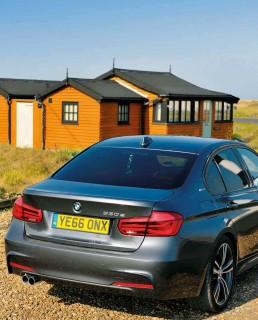
In fact, our M Sport Saloon test car looks anything but the automotive eco-warrior it actually purports to be. Its dark mineral grey paint combines menacingly with bicolour orbit 19in M Sport alloy wheels and darkly-tinted sun protection glass, giving an impression of purposeful power, with more than a hint of aggression!
The most obvious tell-tale signs are the smallish ‘eDrive’ badges on the C-pillars, and the boot-mounted ‘330e’ script. Look a bit closer and the more observant will spot a fuel filler-like flap in the front, nearside wing, just behind the wheel, which hides the recharging port. Our car was also fitted with M Sport brakes, as part of the M Sport package which, more by coincidence than design, I think, feature blue-painted calipers.
Inside it’s standard 3 Series fayre; all very functional and neat. I did notice quite a drop down into the sports seats when settling in, but maybe that’s just in comparison to my F30 520d daily-driver. Just about the only obvious departure from the normal spec I spotted was the appearance of a small ‘eDrive’ button, in the rear of the aluminium bezel that surrounds the gear selector lever. This is used to switch between the three driving modes that are available on this car.
BIG CLAIM
The headline figure for this car is, of course, its claimed fuel consumption of nearly 150mpg. Such a return – or anything close to it – would be a real game-changer for a plug-in hybrid but, of course, that’s a consumption figure achieved by the laboratory-based EU testing procedure. It’s not based on any actual, real-world driving and so, like most other claimed mpg figures, can be taken with a pinch of salt.
But I was keen to give it a go, and intended driving a decent number of miles, as efficiently as I could, while using the car as my everyday vehicle. As it turned out, I managed 672 miles, which included a couple of motorway trips, three cross-country jaunts and all the usual local journeys that make up the minutiae of everyday life.
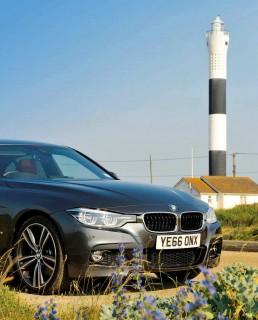
If you’re interested in ‘tech’ then you’ll be interested in this car. The way the electrical power is integrated with the conventional, petrol engine is superb. Coming from a succession of clunky old, stop-start systems on various cars, the way the 330e brings its engine to life was a revelation.
The car chooses to pull away from a standstill in complete silence, using the electric motor, and will accelerate on to a maximum of just over 60mph on electric power alone. However, depending on the conditions, the state of the battery and the severity of the acceleration required, the petrol engine kicks-in as required and, amazingly, it does this in an all but undetectable way.
SILENCE IS GOLDEN
There’s no sound and no vibration when it starts – literally nothing. You can feel no tell-tale judder through the steering wheel or pedals when it fires, and the only sign that it’s done so is movement from the rev counter needle. While running on electric power, this sits at a point marked ‘Ready’ on the dial, but flicks into life the moment the engine starts.
In practice, I found it difficult to match BMW’s claimed 25-mile electric-only range, even with very careful driving in EcoPro mode. Typically, I achieved about 18 miles before the engine cut in. Nevertheless, this would presumably still be enough for many people’s daily commute, drive to the station car park or trip to the shops. So it’s perfectly feasible to imagine visits to the petrol station becoming few and far between for the ‘right sort’ of owner.
Charging the battery pack takes about three hours when using the supplied lead and plugging into a domestic, three-pin socket. Apparently, you can shave an hour off this time by using a dedicated wall box, but I wasn’t able to test this option. The job is simplicity itself and a illuminated bezel around the on-car charging socket provides continuous status updates so you’re never in any doubt about what’s what.
TYPICALLY GOOD DRIVER
On the road the 330e feels like a typical 3 Series to drive. Sharp, accurate steering, great body control and responsive at all times. The brilliant, eight-speed auto ‘box is seamless, of course, and once you’ve got used to the slightly grabby brakes – apparently a consequence of the battery power regeneration system – then all’s well on that front, too. I have read criticisms of the car’s braking performance elsewhere, and did notice a degree of variation on stopping power myself, but I didn’t find it a problem. The 330e has also been criticised by some for less-than-perfect handling as a result of the battery pack. This, of course, all depends on your viewpoint. While there may well be differences between this car and a standard model, when both are pushed to the limit on a track, that’s as maybe.

As I see it, the battery pack weighs about the same as two extra passengers, and that’s not enough to hamper its handling. For the majority of owners, the 330e will prove to be a nimble, fine-handling BMW that will do everything that’s asked of it with confidence-inspiring style. It’s a car which can be hussled down twisty B-roads to great effect and, in that respect, is a pleasure to drive.
What wasn’t so great on our test car was the tyre noise, which on some road surfaces, was pretty intrusive. This was such a shame given the car’s virtually complete lack of mechanically-generated noise. So, although the 19in alloys look great, my advice would be to stick to the smaller, 18in rims and spend more time reveling in the peace and quiet.
ANNOYING REFLECTIONS
Another slight disappointment concerned the dashboard. For a start, the dials on our car weren’t backlit during the day, which meant that they were often hard to read. This was made all the worse by reflections on the cover glass in front of the dials. You would have thought that in this day and age, with all the benefits of high-powered CAD systems, that dial visibility problems would be a thing on the past. Alas, no…
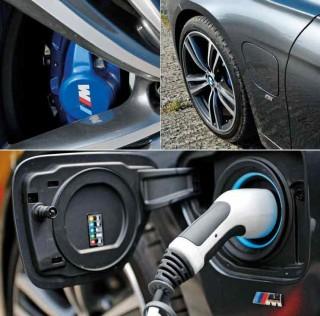
Overall, though, having driven the 330e for nearly 700 miles, it’s a car that I could certainly live with. I enjoyed its technical excellence, and the masterful way the two power sources are managed. So what about that all-important fuel consumption figure, then? Well, unsurprisingly, I didn’t get anywhere near what BMW claims is possible, but did manage to return a solid 48.8mpg, overall.
As I see it, that pretty well matches real-world diesel two-litre economy, which is an impressive achievement for a sporting, turbo-charged, petrol-engined car. Granted, I was driving very carefully most of the time, and had constantly to resist the considerable performance this car has to offer. There’s a really noticeable difference between Eco Pro and Sport driving modes and, when in the latter, the car is much more responsive and actually feels faster than its official performance figures suggest.
As an example of the plug-in hybrid genre, the BMW 330e is a fine car. It’s not cheap to buy; the car here costs £37,275 (without extras), which is about £2,000 more expensive than the equivalent 320d M Sport and a whopping £5,000 more than a petrol-powered 320i M Sport. But, then again, it does bring with it tax advantages, environmental benefits and a level of technical innovation that’s hard not admnire. It’s also an indicator that BMW is taking the ongoing development of its iPerformance brand very seriously indeed.
Having driven the 330e for nearly 700 miles, it’s a car that I could certainly live with.
43% of BMW 3 Series registrations are for the plug-in hybrid 330e model in the Netherlands.
One of the best things about the 330e is that it doesn’t shout about its environmental credentials.
Above: The sound insulation of the two-litre, turbocharged engine is simply superb from the driver’s seat. Below: This M Sport version with 19in alloys looks the part, but sadly suffers with intrusive levels of tyre roar on bad road surfaces.
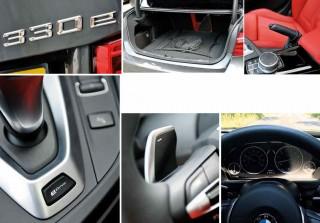
Clockwise: Blue-coloured M Sport brake calipers add an extra touch of visual interest behind the stylish, bicolour
alloys fitted to this car; the charging socket is hidden behind this petrol filler-like flap in the front, nearside wing.
It can’t be opened unless the car is unlocked; recharging the battery is a breeze using this connector, which has a
household, three-pin plug on the other end. It takes about three hours.
Clockwise: The battery pack undoubtedly eats into boot space but it’s surely still large enough for most occasions; old school – it’s nice to have a conventional handbrake lever, for a change!; understated badging; this small ‘eDrive’ button enables the selection of one of three battery-related driving modes; some of the detail touches in the 3 Series interior are great – I particularly like the feel of these gear change paddles, which have sensuously-smooth and beautifully-shaped rear surfaces!; on the downside, a lack of instrument backlighting, combined with sun reflections, makes the dials unnecessarily difficult to read at times.
Despite the battery pack’s decidedly rearward location, the 330e still retains decent weight distribution and good handling, as a result.
YES OR NO?
PLUS POINTS
- 3 Series practicality
- Understated looks
- Tech innovations
- Petrol/electric integration
- Involving to drive
- Silent mechanicals
- Diesel-matching economy
MINUS POINTS
- Tyre noise
- Dashboard visibility
- Stiff suspension
- Limited electric-only range
Darkish metallic paint colours are great for highlighting interesting body contours which ‘flat’ colours obliterate.
With more than just a cursory nod to environment concerns, the BMW 330e brings an interesting and technologically-involving offering to the plug-in party.





